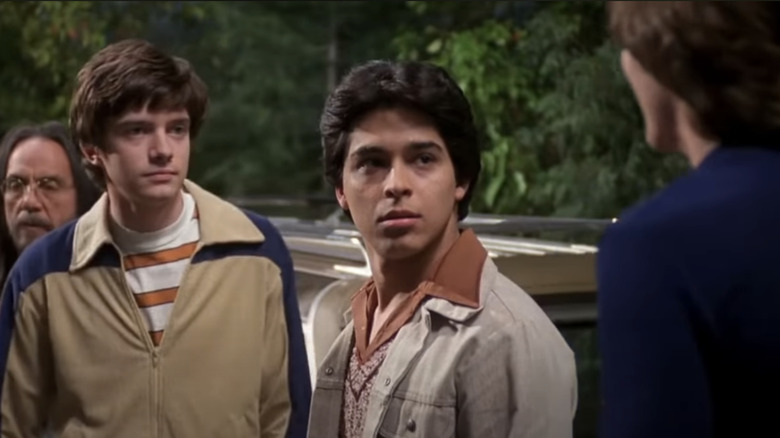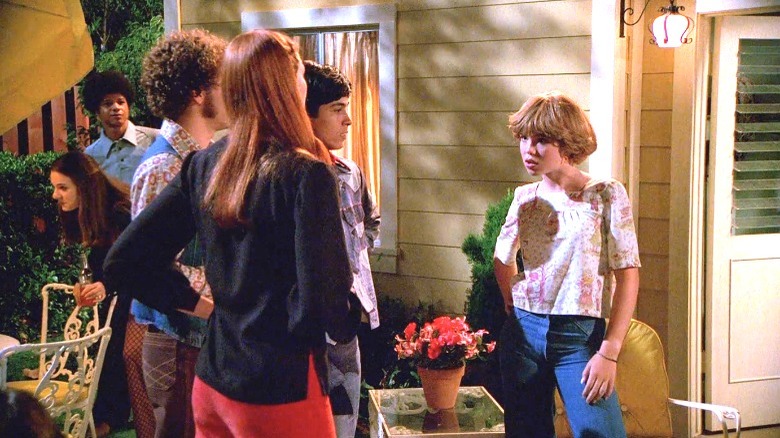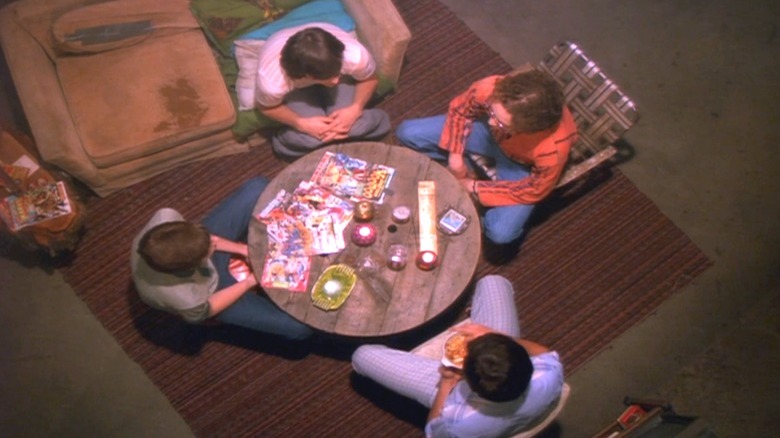That '70s Show Made A Litany Of Continuity Mistakes (But We Still Love It Anyways)
On "That '70s Show," the very short-lived spin-off "That '80s Show," and the recent hit spin-off "That '90s Show," for all the things they get wrong, the look and feel are as authentic as they can be. Melina Root was the costume designer for all three shows and she went to great lengths to make sure that the clothes looked as true to the time period as possible. In a 2002 interview with The Hollywood Reporter, the designer said she developed the costumes from "That '70s Show" by digging through old yearbooks from the Wisconsin area.
Greg Grande, the set designer for "That '90s Show," told House Beautiful in an interview that their magazine was one of the ones he looked through to reference things like prints, patterns, drapery, and pillows. He also mentioned that he had to scour vintage stores and antique malls to come up with the furniture pieces, as he found that many people still have the furniture that they bought in the '90s.
But that's about where the authenticity of the franchise ends, because the internal timeline of the shows makes very little sense, leaving viewers scratching their heads about a lot of things that don't add up. In "That '70s Show," the look and feel of the decade may have been right, but characters dropped off and disappeared, there are constant anachronisms, and of course, there are entirely too many Christmases.
Witness the amazing disappearing Pinciotti sisters
One of the biggest problems with the "That '70s Show" timeline is the fact that it somehow covers the years 1976 to 1979 in eight seasons. That's fine if you assume that each season takes place over less than a year — until you remember the series has five Christmas episodes. Are they celebrating more than one Christmas a year? Did they get confused because of the long Wisconsin winters? Do the opening credits depict the moment before a hideous car wreck, after which the characters all found themselves in purgatory, forced to keep reliving the '70s for the rest of their lives? Probably not. Although, one fan theory thought up by u/NurseBerry in a Reddit thread suggests that in the episode "Tornado Prom," Eric fell into a coma and the rest of the series takes place in Eric's mind, which sort-of explains the never-ending Christmases.
Then, of course, there's the problem with Donna's missing sisters. Donna was originally supposed to be the middle child between older sister Valerie Pinciotti, who was said to be off at college in "Eric's Birthday," and younger sister Tina Pinciotti, who was actually seen on screen in "Eric's Burger Job." However, both sisters mysteriously disappeared and Red says in "That '90s Show" that "There's only one girl in the world with Bob as her dad," thus confirming that Donna must be an only child.
The writers, much like the characters, have a hazy memory of the '70s
Finally, there are anachronisms throughout the show. In Season 1's "That Wrestling Show," for example, the gang goes to a WWF event, but, according to theSporting.blog, Vince McMahon's pro wrestling federation — now known as the WWE — has undergone several name changes over the years and would have been known as the World Wide Wrestling Federation (WWWF) in 1976. Furthermore, Rocky Johnson (Dwayne "The Rock" Johnson, playing his father) only started working for the WWE in the early '80s, or several years after the events depicted on "That '70s Show."
Similarly, in the Season 4 episode "Everybody Loves Casey," the gang repeatedly talks about going to Six Flags Great America in nearby Gurnee, Illinois, but according to an article in Themerica, that park was not bought by Six Flags until 1984.
There are really too many mistakes in the "That Show" universe to cover all of them. But within the vaguely nebulous 1970s depicted in the original show, there were enough nuggets of perfectly authentic nostalgia in the costumes and sets and the overall feel of the series — not to mention all the great humor that wasn't even related to its time period — that we all tend to forgive how it has almost no consistent continuity.


